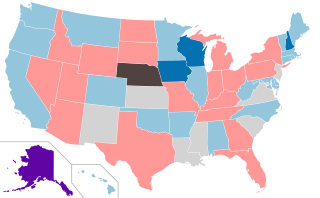Political party strength in U.S. states is the level of representation of the various political parties in the United States in each statewide elective office providing legislators to the state and to the U.S. Congress and electing the executives at the state and national level.
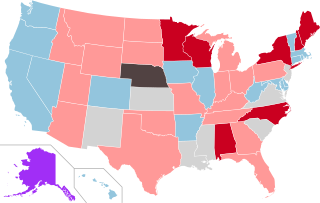
The 2010 United States state legislative elections were held on November 2, 2010, halfway through President Barack Obama's first term in office. Elections were held for 88 legislative chambers, with all states but Louisiana, Mississippi, New Jersey, and Virginia holding elections in at least one house. Kansas and New Mexico held elections for their lower, but not upper houses. Four territorial chambers in three territories and the District of Columbia were up as well.

The 2020 United States state legislative elections were held on November 3, 2020, for 86 state legislative chambers in 44 states. Across the fifty states, approximately 65 percent of all upper house seats and 85 percent of all lower house seats were up for election. Nine legislative chambers in the five permanently-inhabited U.S. territories and the federal district of Washington, D.C. also held elections. The elections took place concurrently with several other federal, state, and local elections, including the presidential election, U.S. Senate elections, U.S. House elections, and gubernatorial elections.

The 2018 United States state legislative elections were held on November 6, 2018, for 87 state legislative chambers in 46 states. Across the fifty states, approximately 56 percent of all upper house seats and 92 percent of all lower house seats were up for election. Additionally, six territorial chambers in four territories and the District of Columbia were up as well.

The 2022 United States state legislative elections were held on November 8, 2022, for 88 state legislative chambers in 46 states. Across the fifty states, approximately 56 percent of all upper house seats and 92 percent of all lower house seats were up for election. Additionally, six territorial chambers were up in four territories and the District of Columbia. These midterm elections coincided with other state and local elections, including gubernatorial elections in multiple states.
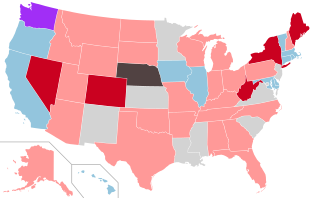
Elections to state legislatures were held in 46 U.S. states in 2014 with a total of 6,049 seats up for election. Six territorial chambers were up in four territories and the District of Columbia.
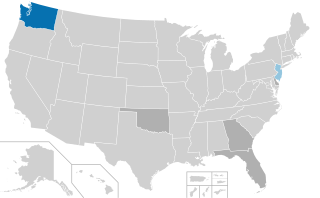
The 2017 United States state legislative elections were held on November 7, 2017. Three legislative chambers in two states held regularly-scheduled elections. These off-year elections coincided with other state and local elections, including gubernatorial elections in two states.

The 2015 United States state legislative elections were held on November 3, 2015. Seven legislative chambers in four states held regularly-scheduled elections. These off-year elections coincided with other state and local elections, including gubernatorial elections in three states.

The 2013 United States state legislative elections were held on November 5, 2013. Three legislative chambers in two states held regularly-scheduled elections. These off-year elections coincided with other state and local elections, including gubernatorial elections in two states.

The 2011 United States state legislative elections were held on November 8, 2011. Eight legislative chambers in four states held regularly-scheduled elections. These off-year elections coincided with other state and local elections, including gubernatorial elections in four states.

The 2016 United States state legislative elections were held on November 8, 2016, for 86 state legislative chambers in 44 states. Across the fifty states, approximately 65 percent of all upper house seats and 85 percent of all lower house seats were up for election. Nine legislative chambers in the five permanently-inhabited U.S. territories and the federal district of Washington, D.C. also held elections. The elections took place concurrently with several other federal, state, and local elections, including the presidential election, U.S. Senate elections, U.S. House elections, and gubernatorial elections.
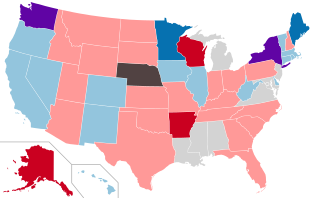
The 2012 United States state legislative elections were held on November 6, 2012, for 86 state legislative chambers in 44 states. Across the fifty states, approximately 65 percent of all upper house seats and 85 percent of all lower house seats were up for election. Nine legislative chambers in the five permanently-inhabited U.S. territories and the federal district of Washington, D.C. also held elections. The elections took place concurrently with several other federal, state, and local elections, including the presidential election, U.S. Senate elections, U.S. House elections, and gubernatorial elections.

The 2009 United States state legislative elections were held on November 3, 2009. Two legislative chambers in two states held regularly-scheduled elections. These off-year elections coincided with other state and local elections, including gubernatorial elections in two states. Both chambers of the Northern Mariana Islands legislature were up, which remains the last time they were up in this class of elections.

Elections to state legislatures were held on November 4, 2008, alongside other elections, in which Democrats scored significant gains in a blue wave election. Elections were held for 85 legislative chambers, with all states but Louisiana, Mississippi, New Jersey, Alabama, Maryland, and Virginia holding elections in at least one house. Michigan and Minnesota held elections for their lower, but not upper houses. Seven territorial chambers in four territories and the District of Columbia were up.

Elections to state legislatures were held on November 6, 2007. Seven legislative chambers in four states held regularly-scheduled elections. These off-year elections coincided with other state and local elections, including gubernatorial elections in three states. Both chambers of the Northern Mariana Islands were up as well.

Elections to state legislatures were held on November 2, 2004, alongside other elections. Elections were held for 85 legislative chambers, with all states but Louisiana, Mississippi, New Jersey, Alabama, Maryland, and Virginia holding elections in at least one house. Michigan and Minnesota held elections for their lower, but not upper houses. Six chambers in three territories and the District of Columbia were up as well.

The 2002 United States state legislative elections were held on November 5, 2002, halfway through President George W. Bush's first term in office. This was a unique election in which the incumbent Republican party performed surprisingly well for a midterm election. Elections were held for 91 legislative chambers, with all states but Louisiana, Mississippi, New Jersey, and Virginia holding elections in at least one house. Three territorial chambers in two territories and the District of Columbia were up as well.

Elections to state legislatures were held on November 7, 2000, simultaneously with the 2000 United States presidential election. Elections were held for 86 legislative chambers in 44 states, simultaneous to those states' gubernatorial elections. Election occurred in both chambers of each state's legislature, except for Alabama, Louisiana, Maryland, Mississippi, New Jersey, and Virginia. Michigan held elections for the lower house. Six territorial chambers in four territories and the District of Columbia were up as well.

The 2024 United States state legislative elections will be held on November 5, 2024, for 85 state legislative chambers in 44 states. Across the fifty states, approximately 65 percent of all upper house seats and 85 percent of all lower house seats will be up for election. Nine legislative chambers in the five permanently-inhabited U.S. territories and the federal district of Washington, D.C. will also hold elections. The elections take place concurrently with several other federal, state, and local elections, including the presidential election, U.S. Senate elections, U.S. House elections, and gubernatorial elections.
